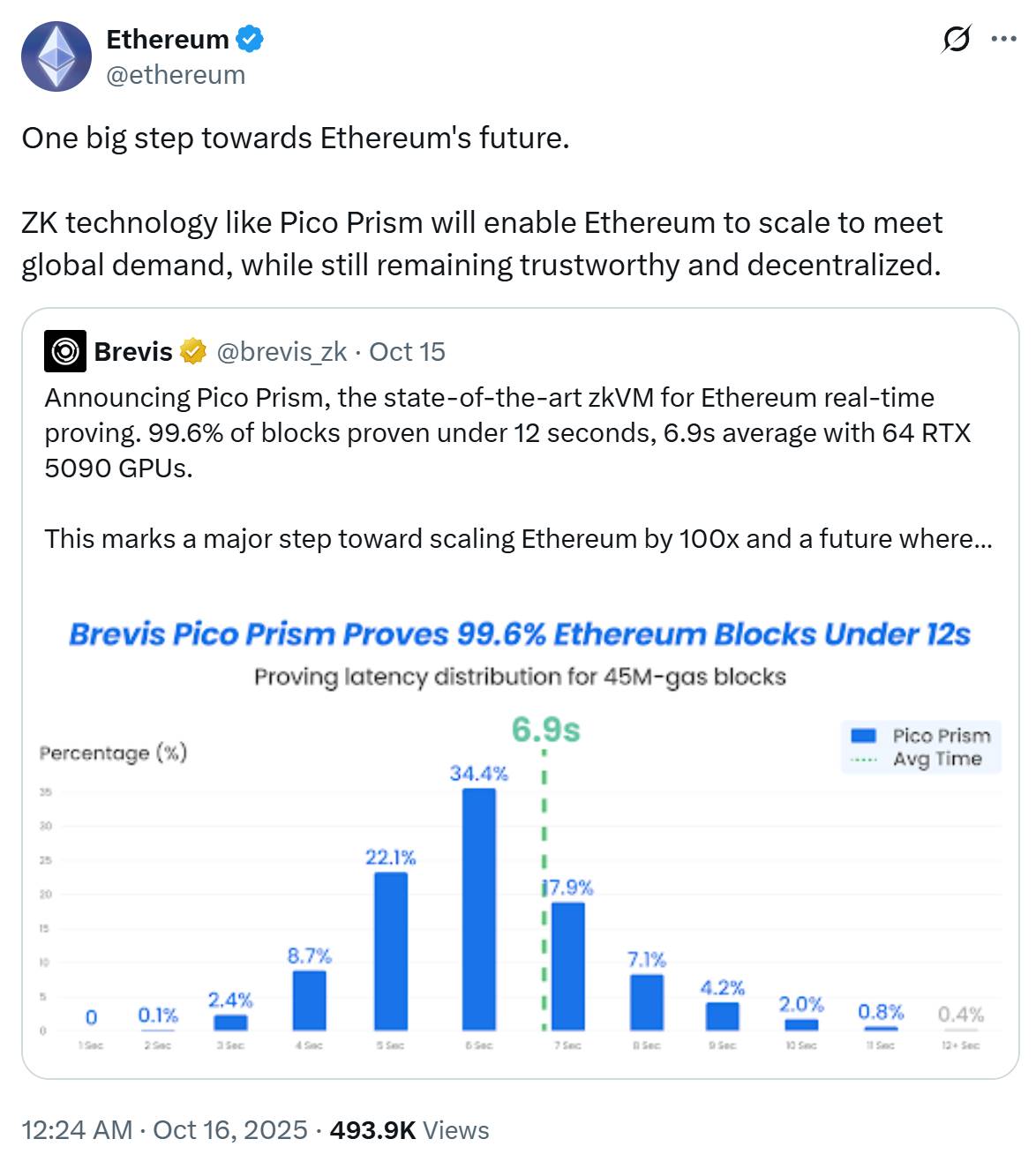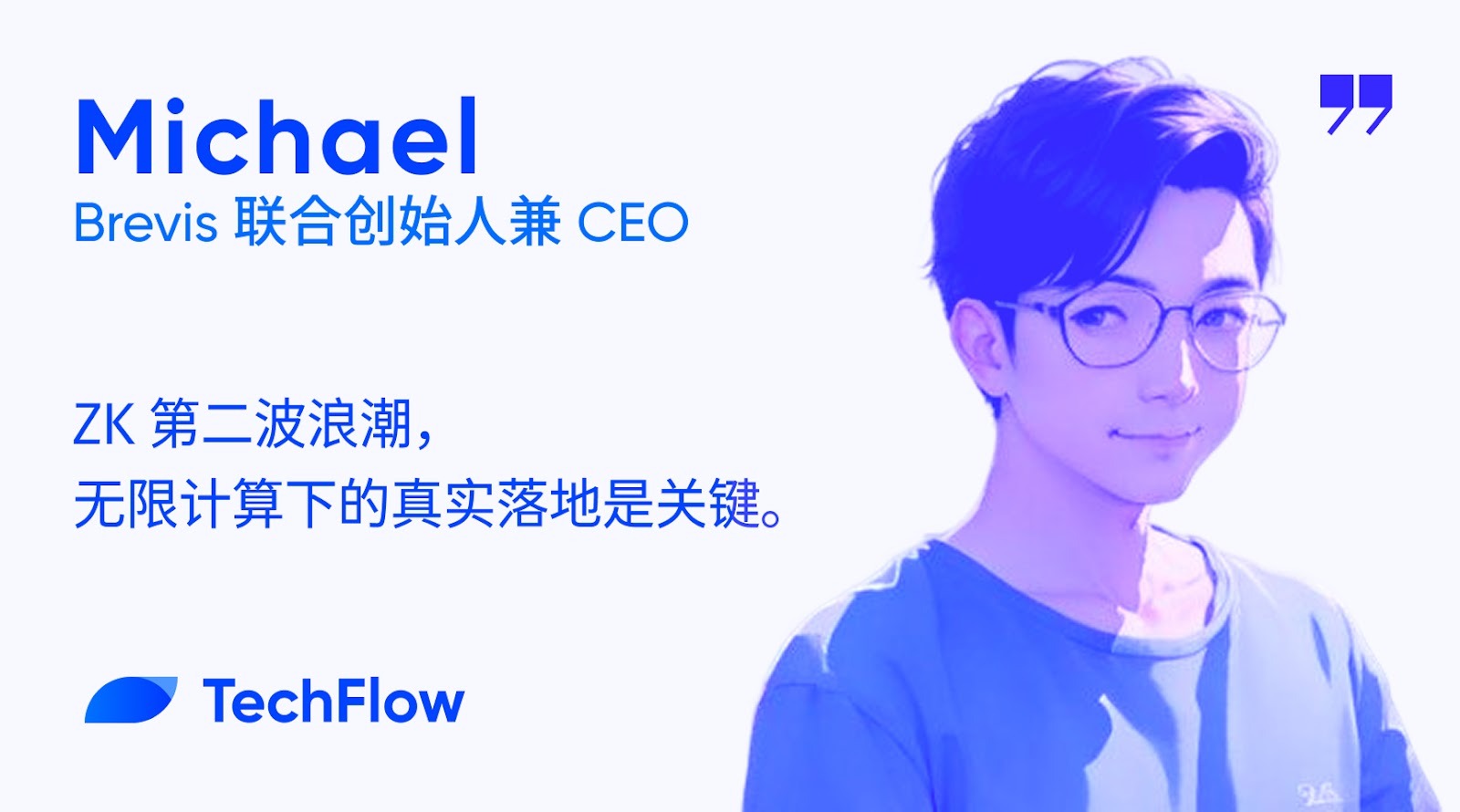以太坊生态发生了什么?吸引 Vitalik Buterin、以太坊官推以及以太坊 OG 研究员 Justin Drake 的集体转发支持与讨论?
2025 年 10 月 15 日,ZK 全链数据计算和验证平台 Brevis 宣布其推出的 zkVM Pico Prism 已在消费级硬件上实现了以太坊实时证明:使用 64 块 RTX 5090 显卡,在 12 秒内完成了 99.6% 的以太坊 L1 区块证明,其中 96.8% 的区块证明时间低于以太坊基金会设定的 10 秒内标准。在 2025 年 9 月 1 日的测试中,在以太坊当前 45M 的 gas 限制情况下,Pico Prism 平均证明时间仅 6.9 秒。
对于本次发布,以太坊官推转发表示:这是迈向以太坊未来的一大步。

从以太坊官推、创始人到 OG,大家难掩的激动情绪都令社区不免好奇:Pico Prism 到底是何重要突破?Brevis 又是如何实现这项重要突破?
在 Pico Prism 宣布实现以太坊实时证明的前夕,深潮 TechFlow 与 Brevis 联合创始人兼 CEO Michael 进行了一场深度对话。
聊到引发本次热议的 Pico Prism,Michael 引以为豪:
这项突破不仅意味着我们现在是全球最快的 zkVM,而且对以太坊社区来说是一个重大进步,能够极大扩容以太坊,甚至实现真正意义上的无限扩容。同时,以太坊实时证明的实现极大提升了区块链的处理效率和确认速度。可以说,这是未来一年以太坊网络重大升级的标志性举措,未来的以太坊可能会彻底转向以 zkVM 为核心的架构。
而谈及 Brevis 与其他 ZK 项目相比的差异化优势,Michael 之间给出了三个关键点:
首先,我们非常注重真实落地,并且已经实现多场景的广泛采用;其次,我们拥有强大的未来可扩展性,能够适应未来不断变化的多元需求。最后,我们拥有易用性和普适性优势,开发者不需要深入了解 ZK 的复杂原理,只要能够简单地生成证明,享受强大的链下计算能力。
最后,作为发展成果与以太坊路线图高度一致的项目,Michael 也围绕「E 卫兵」话题分享了其独特见解:
以太坊不仅代表了当下最成熟、最稳健的技术路线,更代表了一种开放、可验证、尊重开发者和创新的文化,这与 Brevis 的理念高度契合。不过,值得强调的是,Brevis 并非只为以太坊而构建。我们的架构设计本身是多链原生的。我们希望十年后 99% 与以太坊或者说 EVM 相关的计算都发生在链下并通过 Brevis 实现可验证计算。
本期内容,让我们跟随 Brevis 联合创始人兼 CEO Michael 的分享,一起走进 Brevis 多项技术成果背后更深层次的行业发展意义,以及 ZK 第二波浪潮掀起之际,Brevis 的核心差异化优势。

ZK 第二波浪潮到来:Brevis 从实验走向真实落地
深潮 TechFlow:
感谢您的时间,欢迎您先做个自我介绍,也为大家分享一下目前 Brevis 正在做的事情?
Michael:
大家好,我是 Brevis 的联合创始人兼 CEO Michael,很高兴能有机会与大家深度交流。
我技术出身,本科和博士都主攻计算机科学,研究方向是分布式系统和网络计算。过去七年,我一直致力于区块链底层基础设施的建设。在创办 Brevis 之前,我还共同创办了 Celer Network,,这是一个广泛应用的多链交互和跨链桥接平台。
我接触区块链的时间其实挺早,2015 年就开始从事相关的研究和开发,到现在差不多已经有近十年时间。我一直怀揣着一个初心,那就是推动区块链技术的大规模应用。
对于 Brevis,我们称其为「Web3 无限计算层」的解决方案。简单来说,我们的目标是让区块链应用在保持和区块链相同的去中心化和安全性的前提下,能够执行任意复杂计算,从而极大的扩容区块链。
区块链一直被大家视为世界计算机,过去几年也在区块链扩容方面有非常多的尝试和进步,但它仍然非常笨重,根本性原因在于当一个计算在区块链上发生时,所有的节点需要把所有东西重复执行一遍,导致链上计算又慢又贵。Brevis 在做的一件事情就是说如果你遇到了在智能合约里太复杂的计算,你就把它扔到链下,然后生成一个零知识证明,这是一个非常安全的数学证明,用于验证这个链下计算的正确性和可靠性,然后链上合约就不用再去做复杂计算本身了,只需要快速验证这个数学证明,这既保留了区块链本身的去中心化和安全性,同时又能让应用获得传统的计算性能。
目前 Brevis 已经不是一个实验性项目,我们已经服务了非常多的头部的 DeFi、基础设施、稳定币等等项目,包括像 PancakeSwap、Metamask、Linea、Uniswap 等。我们在主网上已经生成了超过 1 亿份 ZK 证明,合作伙伴的使用用户加起来已超过 19 万,帮助增长了约 40 亿美元的 TVL,分发了超过 3 亿美元的可验证奖励计算。
总体来说,Brevis 旨在 Web3 场景下,能够让智能合约第一次拥有无限计算能力,让区块链本身从只能做简单计算、执行简单金融规则,变成一个真正强大的智能系统,这是我们要做的事情。
深潮 TechFlow:
我们知道,Brevis 对 ZK 的探索源于 2023 年,当时 ZK 领域正处于早期阶段,当时如何选中了这个赛道?
以及现在一些 ZK 相关的几个头部项目如 Starknet、zkSync 貌似并没有以前那么热门,甚至让市场不看好 ZK 相关的项目。 这种现象对你们产生过什么影响吗?最后为什么坚持了这个方向?
Michael:
在我看来,任何技术浪潮的发展都是有节奏的。通常情况下,新技术兴起的第一波应用会非常局限,而第二波的应用场景会极大拓展。
我们可以回顾互联网历史上的每一项新技术,都经历过这样的过程。比如说,移动互联网经历了两波浪潮:从最初的简单应用到整个互联网都搬到移动端,包括短视频的兴起。AI 的发展也经历了类似的过程,最初它只能解决一些特定的小问题,而随着算力的爆炸,才带来了像大语言模型(LLM)这样的新一轮周期。
ZK 也是如此。2021 年左右 ZK 成为区块链领域的一个讨论热点,但当时其实际应用场景非常局限,主要集中在基于 ZK 的二层网络上。我们认为,ZK 作为 L2 解决方案虽然是一个很好的应用案例,但应用场景非常局限,且还面临着包括 Optimistic Rollup 的竞争。
直到 2023 年,ZK 进入冷静期,但对于我们这种做基础设施的团队来说,这并不是问题的关键。我们并不单纯把自己视作一个 ZK 项目,我们并不是用技术驱动产品,而是通过需求驱动产品。我们想要解决行业中实际存在的问题,而 ZK 正好是解决这些问题的一个有效方案。我们要解决的问题在于,如何让大规模计算变得可验证,并且能够在区块链上执行。ZK 不是目的,而是一种手段。
我们与其他 ZK 项目的主要区别在于,我们能够让 ZK 真正进入真实场景和用例。例如,在 PancakeSwap 我们发现项目为不同用户提供定制化体验的需求,尤其是需要基于交易量为大户提供不同的手续费率。这种需求在传统的智能合约中是无法实现的。我们通过 ZK 技术,让大户能够生成一个关于交易量的证明,然后智能合约根据这个证明来执行不同的手续费率,从而实现差异化的用户体验。
在与 Euler 的合作中,项目希望能够不是简单地进行这借贷激励,而是能够通过基于时间加权等非常复杂的模型去更好的分配奖励,之前这也是无法在智能合约上实现,现在我们也通过 ZK 进一步解决。
还有一个例子是 Linea 平台,它通过 ZK 实现了一个复杂的、基于时间加权的激励分配模型,保证了激励分配的合规性、安全性和透明度。这个激励分配方案无法通过传统智能合约实现,但通过ZK技术,我们能够成功实现这个需求。
从这些实际应用中,我们可以看到,ZK 技术不仅能解决复杂的计算问题,还能帮助实现更符合用户需求的定制化服务。我们已经有多领域成千上万的用户在使用这些系统。
所以说我们其实是一个以需求为导向、以需求驱动产品技术发展的项目,我们认为只有这样才能把 ZK 带入更广泛的应用场景,推动 ZK 2.0 时代的到来。
真实应用、无限扩展、易用普适:Brevis 差异化竞争三大关键词
深潮 TechFlow:
ZK 具有较高理解门槛,且行业中的 ZK 项目不止 Brevis。相比较其他 ZK 项目,如果用三个关键词,帮助读者快速了解 Brevis 的差异化优势,您认为会是哪三个关键词?
Michael:
首先,我们非常注重真实落地。很多 ZK 项目仍停留在学术概念阶段,或是专注于与用户没有太大关系的应用场景。而我们从一开始就以需求为驱动,已经有多个应用场景在每天处理成千上万的用户请求,实际解决了大量真实需求。我们现在更关注的是,ZK 能否在主网上成功上线,每天处理百万次的证明,而不是仅仅讨论技术的潜力。因此,我们的核心目标是通过 ZK 技术服务实际用户,确保技术在现实世界中的落地和实际应用。
举个例子,在我们实现 zkVM 时,我们的思路并不仅是简单的构建一个可以计算所有东西的 zkVM 就行了,而是要确保它能够支持像 PancakeSwap、MetaMask、Linea 等项目的需求。因此,我们设计了一个非常模块化的架构,能够根据不同的应用场景接入不同的Coprocessor,这是我们一个非常主要的区别,我们既有 VM,又有各种各样的 Coprocessor可以接入 VM 去处理应用场景需求,真正将 ZK 技术从理论研究转化为生产力。
第二个区别是强大的未来可扩展性。我们并不仅仅搭建了一个单一的协处理器或 zkVM,而是设计了一个非常模块化的系统架构,确保它能够适应未来不断变化的需求。当前,我们的架构包括 Pico zkVM 和 ZK Coprocessor 两个核心模块。Pico zkVM 负责验证计算的正确性,而 ZK Coprocessor 能够处理更复杂的应用需求,例如智能合约访问区块链历史数据,或验证用户过去的行为。
通过这种架构,我们不仅能够支持数据隐私、区块链历史验证等应用,还能迅速集成新的技术模块。我们最近在开发 ZK-TLS 并计划很快上线。同时我们还在探索 AI 相关的 ZK Coprocessor。这种高度可扩展的设计确保了我们的系统能够适应未来多维度的应用场景。
第三个区别就是易用性和普适性。我们希望我们的系统架构能够被广泛的开发者使用,而不仅仅是那些精通密码学或 ZK 技术的专业人士。我们设计的目标是让开发者在接触 ZK 技术时,不需要深入了解 ZK 的复杂原理,只要能够简单地生成证明,并让区块链低成本地验证这个证明,就可以了。
为了实现这一目标,我们基于 zkVM 搭建了技术架构,使开发者只需编写熟悉的 Rust 程序,而不需要学习复杂的零知识证明开发工具。这种设计降低了开发者的门槛,使他们能够轻松将自己的应用集成到 ZK 技术中,享受强大的链下计算能力。
万物无限计算层:为 Brevis 带来无限应用创新场景
深潮 TechFlow:
最近因为 ZEC 异常强势,大家又开始关注隐私和 ZK 相关代币,刚才您也有提到早期的 ZK 比较局限,那么和 ZEC 等老 ZK 叙事相比,Brevis 的 ZK 技术有何升级?
Michael:
首先我们谈谈「零知识证明(ZK)」,在中文中通常被简称为「零知识证明」,但它的完整含义是「零知识简洁证明」。
ZK 技术实际上应用于两个主要领域:一个是隐私保护,另一个是简洁性。隐私领域主要是确保交易和数据不会被外界看到,保证数据的私密性。而在简洁性方面, ZK 技术允许我们将复杂的计算任务移至链下处理,生成一个简洁的证明,再由区块链验证这个证明,从而显著提高区块链的计算能力。
在区块链领域,ZK 的应用现在更多集中在这种简洁的证明方式上。举个例子,我们可以帮助 PancakeSwap 验证用户是否进行了某些交易,或者在跨链平台上证明某些数据是否真实。这种通过链下计算生成证明,再通过链上验证的循环,使得区块链能够在不牺牲去中心化和安全性的前提下,处理更复杂的计算任务。
在隐私保护方面,ZK 的优势非常明显。举个例子,我们最近和 Kaito 合作推出了一个基于 ZK 的 Yapper 排行榜功能。大家都知道当下嘴撸文化非常盛行,很多人通过发布推文提高自己的排名并获得奖励。问题在于很多人声称自己是大户,拥有巨额交易量,但如何证明这一点呢?如果用户直接公开自己的钱包地址,就可能会暴露隐私,成为目标。
为了解决这个问题,我们和 Kaito 一起设计了一种新的方式,用户可以通过 ZK 证明自己拥有一个符合特定条件的钱包而无需公开钱包地址。例如,一个用户可以生成证明,表示他持有 100 万美元的某个代币,而无需暴露自己的钱包地址。这种方式既保护了用户隐私,又可以证明用户的身份或声誉,从而提高在排行榜中的权重。
ZK 技术的隐私保护不仅限于这种身份证明应用,它还可以广泛应用于其他场景,比如在 DeFi 领域。比如,用户可以通过 ZK 证明自己是某种特定代币的长期持有者,或者是某个 DeFi 协议的活跃交易者。这样,在未来的 DeFi 项目中,开发者可以为这类用户提供定制化的激励,比如更优惠的借贷利率或奖励,从而增强用户粘性。
另外,ZK 在永续期权合约交易所中的应用也是一个非常典型的例子。比如在诸如 Hyperliquid 这样的去中心化交易所中,用户的交易、订单簿和持仓等数据通常是公开的,这可能导致“定点爆破”或被恶意攻击的问题。而在中心化交易所中,虽然有暗池来保护交易信息,但去中心化交易所则面临无法平衡隐私和透明度的问题。
通过 ZK 技术,我们能够实现类似中心化交易所的隐私保护,而不需要公开用户的具体交易数据或订单详情。每笔交易、每笔订单的匹配、每个用户的余额都可以通过 ZK 证明其正确性,而不暴露用户的详细数据。我们正在与一些领先的永续期权平台合作,准备推出这一功能。
最后,虽然 ZK 技术最先在隐私保护方面展现了强大的潜力,但目前在 Brevis 更是一种无限计算层的新范式,在提升区块链计算能力上发挥着重要作用。未来,我们会看到ZK技术在隐私与计算能力的结合中发挥更大的作用,这将推动 ZK 2.0 时代的到来。
深潮 TechFlow:
作为「万物的无限计算层」,如何理解这里的「无限」?这种「无限」具体体现在哪些维度?
Michael:
首先,Brevis 拥有无限的计算能力。
我们回到非常基础的问题:区块链计算的限制。传统区块链的计算模式存在一个核心瓶颈,那就是计算成本。在传统区块链中,成千上万的节点必须对相同的计算进行验证,所有的计算都要重复执行一遍,直到得出一致的结果,这样才能达到共识。尽管这种方式确保了区块链的安全性,但想象一下,哪怕是一个简单的 1+1 计算,这个过程重复执行 100 万次,成本也会非常高。这就是区块链计算本身的核心问题,计算的复杂度和成本成正比。
而 Brevis 的优势在于,通过先进的 ZK(零知识)可验证计算模型,能够让计算任务在链下完成。只需要一个节点完成复杂的计算,并生成一个简洁的零知识证明,其他节点只需验证这个证明就可以了,且验证这个零知识证明是非常简单的。比如说,一个复杂的计算本来需要每个节点都参与,导致成本是节点数的倍数,而通过 Brevis,验证证明的成本可能只相当于原计算成本的百万分之一。
这种方式大大降低了区块链中计算的复杂度和成本,使得区块链能够处理更复杂的任务,并且解决了计算能力有限的问题。这样,区块链不再受到 Gas、TPS、区块时间等传统限制的束缚,能够真正实现所谓的「无限计算能力」。
第二方面,Brevis 拥有无限的应用场景。我们的官方应用页面非常丰富,包括稳定币的冷启动、区块链增长、RWA、永续 DEX、InfoFi,再到像 MEV、 Rollup、智能 DeFi 等等,Brevis 都能为其提供强大的计算支持。我们通过 Pico zkVM 和 ZK Coprocessor 等核心产品,使得可验证计算技术能够广泛应用于这些场景。
第三,我们非常重视开发者体验,可以说是追求无限的低门槛开发体验。传统的 ZK 应用开发往往需要深入理解密码学、电路设计和证明系统,这对很多开发者来说非常复杂。相比之下,Brevis 通过 zkVM 给开发者提供了一个非常高层次的抽象。开发者只需使用自己熟悉的编程语言,如 Rust 或 Go,来编写想要的逻辑,而不需要了解复杂的 ZK 原理和开发工具。
这使得开发 ZK 应用变得更加简单和高效,同时也让更多的开发者能够快速上手,进入这个领域。我们能够看到大量不同的应用场景,因为 Brevis 让开发者的工作变得更加自由和灵活,极大地提升了开发效率。
深潮 TechFlow:
这种「无限」,能为 Web3 乃至 Web2 带来哪些改变?
Michael:
从宏观角度来看,隐私技术不仅解决性能问题,它更深层次的作用在于信任模式的彻底转变。传统互联网的计算架构一直是集中式的,所有的数据处理和计算都由中心化的实体来完成,用户只能信任这些中心化的计算方式。这种模式固然有效,但也存在很多局限性。
Web3 的出现试图颠覆这种中心化的信任结构,推动去中心化的计算和资产管理。然而,去中心化本身也带来了性能上的挑战,计算的复杂度增加了去中心化的成本,这成为 Web3 发展的瓶颈。Brevis 的出现,能够将去中心化和强大的计算能力有效结合,为 Web3 带来了无限计算层,解决了去中心化信任与计算能力之间的矛盾。
例如,现有的智能合约,尽管号称智能,但实际上还是比较傻。举个简单的例子,智能合约并不能访问用户的历史交易数据,也无法执行复杂的逻辑计算。像是通过多个协议计算出用户对生态系统的贡献指数,这样的计算在区块链上是无法完成的。而 Brevis 的无限计算层则能突破这种限制,使智能合约真正具备智能,能够支持动态激励、个性化费率、时间加权奖励等原本无法实现的功能。
这意味着,Web3 不再是一个仅仅处理简单交易的系统,它能够承载更复杂的应用逻辑,甚至集成智能决策、人工智能等高级功能,真正实现去中心化的智能链上世界。
除了 Web3,Brevis 在 Web2 中的潜力也非常大。比如我们目前所看到的 AI 模型训练大多数依赖于公有域数据,比如通过 Reddit、Google 等公共平台获取的数据。这些数据虽然广泛,但与用户私密数据相比,它们的价值远远不及私域数据。然而,目前并没有一种有效的方式来管理和交易这些私域数据。用户无法直接将自己的数据交给别人,毕竟这些数据涉及隐私。
通过 Brevis 可验证计算,用户可以证明某些数据的有效性而无需暴露具体细节。例如,如果我想知道某个人在过去一个月内的交易情况,但又不希望暴露他每一笔交易的细节,Brevis 可以用 ZK 来验证这些数据的真实性,同时确保用户隐私不被泄露。这为 AI 模型训练提供了全新的数据流方式,并改变了传统数据使用的信任模式。
此外,去中心化的 AI 应用也可以受益于可验证计算。假设我们有一个医疗 AI 模型,用来分析医学图像,判断病情是否严重。如果这个模型的输出结果来自一个未验证的低质量模型,用户就无法信任这个结果,而通过 Brevis,我们可以确保每一个 AI 模型的输出都能被验证,确保其来自一个高质量模型。这种方式使得去中心化的 AI 不仅仅是一个理念,而是可以在现实中落地,并提供高质量的服务。
Brevis 的核心作用就是打破传统 Web2 和 Web3 之间的信任壁垒,使得数据和计算在保证隐私的前提下,能够在去中心化环境中进行验证和处理。这不仅是 Web3 的技术突破,也为 Web2 提供了一个全新的信任模型和数据使用方式。
无论是 AI 模型训练、去中心化金融,还是智能合约的执行,Brevis 的技术都在改变整个数据流通和计算的方式。我们正迈向一个更加去中心化、更加智能化的未来,Brevis 为这个变革提供了强大的计算支持和隐私保护机制。
深潮 TechFlow:
在目前一系列的合作伙伴中,能否请您通过具体的生态案例,帮助读者更直观的了解 Brevis 带来的改变?
Michael:
我刚才也有提到很多,现在就对生态应用进行一个简单的分类吧。
首先是在智能 DeFi 领域,我们能够帮助不一样的 DeFi 的协议根据用户过去的历史行为,或者是根据整个市场的变化,动态调整整DeFi 用户体验和 DeFi 数值系统。比如PancakeSwap 就基于 Brevis 的零知识证明技术,推出了新的交易模型,用户可以生成自己的交易量证明,从而获得不同等级的手续费折扣;持有 CAKE 的用户在特定交易池中还可享受额外减免。我们还与很多 DeFi 协议合作,让 DeFi 体验更加个性化、动态化。
接下来,我们还将与 Uniswap 推出 Gas Fee Rebase 项目,用户能根据自己在交易池中的 Gas 消耗生成证明,并获得奖励返还。
第二个案例是稳定币的冷启动,帮助稳定币深度嵌入 DeFi 生态,这需要一个持续的用户激励系统,我们与 Usual Money、OpenEden、MetaMask 等伙伴合作,通过构建去中心化激励系统实现稳定币的持续增长。用户在不同协议中提供流动性或交易后,可以凭借历史行为证明自动获得激励,实现了透明、安全、合规、可验证的分发机制。
此外,我们的合作还体现在区块链本身的增长。有效的区块链奖励分发是持续增长的重要助推力,Brevis 能够让奖励本身变得透明、可验证以及自动化。我们还与 Kernel 合作,通过 Brevis 实现跨链资产的安全证明和奖励发放。
第四类就是刚才聊到的隐私部分,比如我们在 InfoFi 赛道与 Kaito 的合作,能够让用户去在保护隐私的情况下证明自己。以及在 AI 领域,Brevis 也大有用处。
可以说,Brevis 能够应用的场景非常多,同时 Brevis 也通过与非常多的伙伴合作,在非常多的应用场景中实现真实落地。
Pico Prism 以太坊实时证明:以太坊彻底转向 zkVM 的重要标志
深潮 TechFlow:
在实现「万物的无限计算层」的过程中,Brevis 已经取得了哪些实质性技术突破,可否请您向我们介绍一些关键进展?
Michael:
当然,过去一到两年里,我们在技术上取得了一些非常重要的突破。最值得一提的是我们刚刚上线的 Pico zkVM 的 Prism 版本,这是一款非常强大的零知识证明虚拟机。它可以证明任何计算,无论其复杂度如何。这是我们的核心产品之一,它能让任何计算都通过 ZK 证明。
尤其是我们最近推出的 Pico Prism 多 GPU 版本,我们已经在消费级硬件上实现了 99.6% 的以太坊主网区块实时证明覆盖率,平均证明时间仅需 6.9 秒,比当前第二快的 zkVM 解决方案快 70%,并且成本降低了 50%。整体性能效率提升了 4 倍,这对我们来说是一个非常重要的突破。
这项技术突破为什么如此重要呢?
这个突破不仅意味着我们现在是全球最快的 zkVM,能够以更低的成本、更高的效率生成证明,更重要的是,这对以太坊社区来说是一个重大进步。
以太坊作为一个去中心化、安全优先的解决方案,长期以来在可扩展性和性能上面都存在较大的瓶颈。传统的以太坊网络由成千上万的节点组成,每个节点都需要计算相同的内容。想要扩展区块容量,节点的计算量也会线性增加,这就导致了成本的暴涨。
而通过可验证计算的方式,我们的模型发生了根本性的改变。如今,只需要一个节点来生成一个区块的 ZK 证明,而这个证明可以被整个网络的数百万节点验证,验证所需的计算能力只是区块计算本身的万分之一,甚至更少。
ZK 的特别之处在于,无论计算任务有多复杂,生成证明的时间不会因为任务的规模扩大而增加。当我们处理大量复杂数据时,所需的证明时间几乎保持不变。
通过这一技术特性,我们能够立刻将以太坊的扩容能力提升 10 倍甚至 100 倍。这非常简单,只需要在生成证明的节点上增加更多的 GPU,就能显著提升交易处理能力。我们估测,我们能够在短期内对以太坊实现 1000 倍的提升。
此外,由于 Pico zkVM 支持多 GPU 并行计算,我们可以在网络层面通过优化,进一步提升整个以太坊网络的计算能力。这意味着,在不增加大量额外计算资源的情况下,区块链能够应对更高的交易量,甚至实现真正意义上的无限扩容。
实时证明是以太坊未来发展的一个关键点。实时生成证明意味着区块一旦生成,我们就能够即时验证其有效性。通过这种方式,区块链的处理效率和确认速度得到了极大的提升。而这也为以太坊的升级铺平了道路,未来的以太坊可能会彻底转向以 zkVM 为核心的架构,取代现有的重复计算方式。在未来的一年内,这将成为以太坊网络重大升级的标志性举措。
模块化是我们技术的另一大亮点。通过强大的插件系统,我们能够在 zkVM 基础上实现各种特定功能的扩展。例如,我们推出的 ZK Data Code Processor,它能够赋予智能合约记忆功能。传统智能合约没有历史数据访问能力,而通过这种协处理器,智能合约可以回溯并分析历史数据,进而执行更复杂的逻辑。
这种模块化设计使得开发者能够更加灵活地根据不同的需求扩展功能,同时大大提升了计算效率和成本效益。简单来说,通过 ZK Data Code Processor,我们可以让智能合约在处理类似交易历史等复杂数据时,效率提升 100 倍,成本减少数倍。
TGE 将至:希望未来 99% 的 EVM 计算都是链下发生、链上验证
深潮 TechFlow:
TGE 将至,Brevis 也推出了 Brevis Proving Grounds 活动,用户可通过完成任务获得 Brevis Sparks,这也是决定 TGE 空投分配的重要方式。作为普通用户,如何更有效的参与其中吗?
Michael:
好的,首先关于我们的 Brevis Proving Grounds 活动,规则其实非常明确。我们希望通过这个活动让用户能够真正理解 ZK 技术以及可验证计算的能力边界,而不仅仅是简单地完成一个测试任务。
我们不希望用户只是点击几个按钮,而是希望他们通过参与,能够真实体验智能 DeFi 和奖励分发等实际应用,从中感受到 ZK 技术带来的实际好处。通过这种方式,我们希望用户能够了解我们的服务是如何构建并服务于整个生态系统的。
在这个过程中,我们的目标是与社区共同探索 ZK 技术的潜力,确保大家不仅仅是在完成一个测试任务,而是真正感受到 Brevis 的产品市场契合度。这个活动本身与传统的测试网活动有所不同,它更多是一次关于 ZK 技术能力的深度体验。
深潮 TechFlow:
伴随着 TGE 的到来,Brevis 也将迈向发展的全新阶段。因此可否请您分享一下,接下来 Brevis 的工作重点是什么?
Michael:
一方面,我们会继续扩展开发者生态和合作伙伴生态。我们目前有很多开发者和合作伙伴,计划使用 ZK 或者 Brevis 的 PICO、ZK Coprocessor 等技术来构建各种应用。
另一方面,我们的另一个重要目标是上线验证者网络。我们并不打算绑定特定的链或进行全部验证,而是希望将整个 ZK 验证过程去中心化,构建一个分布式的验证网络,这是我们接下来的一个核心工作方向。
深潮 TechFlow:
好像你们团队的重心一直都在 EVM 或者以太坊。你个人是忠诚的「E 卫兵」吗?怎样看待以太坊和 EVM 的未来?
Michael:
Brevis 做的很多工作,包括 Real-Time Ethereum Proving 等都与以太坊未来路线图相关的,很大程度上是因为以太坊目前确实代表了当下最成熟、最稳健的技术路线,且它不仅是公链,更代表了一种开放、可验证、尊重开发者和创新的文化,这与 Brevis 的理念高度契合。
从技术角度来看,EVM 诞生已有十年,依然是区块链行业最具生命力的执行环境。即便是像 BNB Chain 以及各类 Rollup,也都是建立在 EVM 之上。每一次技术迭代都没有彻底颠覆旧有体系,而是在 EVM 基础上进行演化,我认为这是以太坊可持续创新的重要原因。
在 Brevis ,我们的目标是利用 EVM 上的生态来实现可持续的创新。我们希望通过技术架构带来扩容和计算模型的新变化,同时与现有生态系统良好兼容。比如像 PancakeSwap 和 Uniswap 等去中心化交易所,尽管它们使用了不同技术架构,但最终结算仍然依赖 EVM 链。
以太坊对于 zkVM 的需求非常大,尤其是在推动隐私保护和可验证计算方面。从客户和合作伙伴的角度来看,如果以太坊底层网络转向 zkVM 驱动,那么它将成为 zkVM 技术的最大客户。因此,Brevis 聚焦以太坊也是顺理成章的。
不过,值得强调的是,Brevis 并非只为以太坊而构建。我们的架构设计本身是多链原生的,可以支持多种非 EVM 链,包括 Mone、Solana、Cosmos,甚至是任何新的 VM 系统。我们的核心特点是,大量的计算发生在链下,链上只需要验证相关数据,但最后在链上验证的那一个部分是非常简单的,我们只需要去把这个链上验证的合约根据不一样的区块链去做一个适配就可以了,因此 Brevis 可以非常简便地与不同区块链兼容。
我认为很多的「E 卫兵」,都是追求开放标准和长期主义的建设者,从精神上来说,我觉得我们可能是「E 卫兵」,但从具体实现路径以及未来的大规模采用维度来说,我们是一个非常开放的平台。
最后,我个人本身还是非常看好以太网的未来,我认为以太坊是 Web3 安全和创新的示范性代表,Brevis 希望赋能以太坊,将以太坊逐渐地从一个所有逻辑都在链上执行的平台,变成一个单纯做验证的平台,我们希望十年后 99% 与以太坊或者说 EVM 相关的计算都发生在链下并通过 Brevis 实现可验证计算。
免责声明:本文章仅代表作者个人观点,不代表本平台的立场和观点。本文章仅供信息分享,不构成对任何人的任何投资建议。用户与作者之间的任何争议,与本平台无关。如网页中刊载的文章或图片涉及侵权,请提供相关的权利证明和身份证明发送邮件到support@aicoin.com,本平台相关工作人员将会进行核查。




